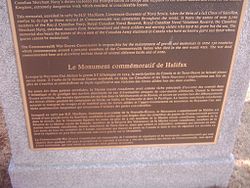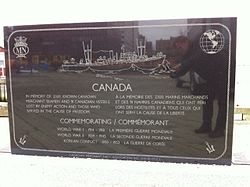History

An informal merchant navy appeared in 1914 at the start of World War I and was renamed Canadian Government Merchant Marine (Marine marchande du gouvernement canadien) in 1918, but slowly disappeared by 1930. [2]
Within hours of Canada's declaration of war on September 10, 1939, the Canadian government passed laws to create the Canadian Merchant Navy setting out rules and controls to provide a workforce for wartime shipping. The World War II Merchant Navy greatly expanded the similar World War I effort. The Canadian Merchant Navy played a major role in the Battle of the Atlantic bolstering the Allies' merchant fleet due to high losses in the British Merchant Navy. Eventually thousands of Canadians served aboard hundreds of Canadian Merchant Navy ships, notably the "Park ships", the Canadian equivalent of the American "Liberty ships". Royal Canadian Navy Rear Admiral Leonard W. Murray reported,
The Battle of the Atlantic was not won by any Navy or any Air Force, it was won by the courage, fortitude and determination of the British and Allied Merchant Navy. [3]
A school was established at St. Margaret's Bay, Nova Scotia to train sailors for the Canadian Merchant Navy, who became known as "Merchant Mariners." Manning pools, or barracks, were built in major Canadian ports to house Merchant Mariners. The Merchant Navy was considered a fourth branch of the Canadian military alongside the Royal Canadian Navy, Canadian Army, and the Royal Canadian Air Force, and suffered the highest casualty rate of the four.
After the war, Canadian Merchant Navy veterans were denied veterans benefits and official recognition for decades. This was not corrected until the 1990s and many individual cases remain unresolved.
An important gesture in 2003 was the designation by the Canadian Parliament of the Merchant Navy Remembrance Day on September 3 as a day to recognize the contributions and sacrifice of Canadian Merchant Mariners. [4]
The Merchant Navy slowly disappeared until by 1950 no Merchant Navy ships were left. [2]







